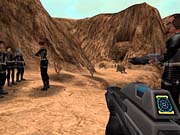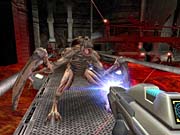Star Trek Elite Force II Updated Preview
The hazard team is back for another adventure. Read all about the next Elite Force game inside.
Ever since it was first announced in April, Star Trek Elite Force II has been under the watchful eye of many a hard-core first-person shooter fan, and for good reason. The follow-up to Raven's Star Trek: Voyager Elite Force is being developed by SiN and Heavy Metal: F.A.K.K. 2 developer Ritual Entertainment, and it replaces the Voyager universe with the one from the far more popular series Star Trek: The Next Generation. We last got a glimpse at the game at QuakeCon 2002 in August, but the developers have been hard at work since then, so we tracked them down to get a general status update, as well as some information on the characters, weapons, races, and other gameplay elements that have been added to the game since we last saw it two months ago.

One thing that hasn't been talked about until now is how the game transitions from the Voyager universe to The Next Generation universe. As any fan will tell you, the two shows took place at the same point on the Star Trek timeline, so Elite Force can actually make that transition without losing the main characters from the first game. In Elite Force II, you will once again take control of Alex Munro, a member of the Starfleet hazard team. In addition to Alex, other members of the team from the first game, including Chell, Austin Chang, Telsia Murphy, and Juliet Jurot, will return. Helping you make the transition is Tuvok, who also played an important role in the previous game. Tuvok will temporarily be assigned to the USS Enterprise-E, and he'll guide the team throughout the game, just as he did in the original. Also taking an important leadership role will be USS Enterprise captain Jean-Luc Picard, who will serve as captain of the ship but will also be involved in specific missions (in contrast to the role Captain Janeway played in the last game, which was pretty much administrative in nature). Both Picard and Tuvok will be voiced by the actors who portrayed them in the series (specifically, Tim Russ as Tuvok and Patrick Stewart as Picard). Other well-known Star Trek characters will be appearing as well, but as the casting has not been locked down, Activision can't give out specifics just yet. We were told that the company is in the final stages of the casting process now, and that "there will be a combination of both returning characters and returning voice actors that will be familiar to Star Trek fans."
The storyline in Elite Force II begins in the Delta quadrant, with the hazard team aboard the USS Voyager. The first mission in the game revolves around "End Game," the final episode of the Voyager series, and Alex and his hazard team play "a pivotal role" in the events in that episode. As in the show, the ship is freed from the clutches of the Borg and returns home to the Alpha quadrant. Although the game initially takes place before Star Trek: Nemesis, once the game moves to the USS Enterprise, the events of that movie will have already transpired. This is because the developers weren't sure if the game and movie would be released at the same time, so while there are ties to Nemesis, the game is not a direct tie-in. But as it takes place on the Enterprise after Nemesis, there are references, and you'll be able to use the new phaser, tricorder, and Romulan disruptor featured in the movie.
Should You Choose to Accept It
As Elite Force II has come a long way since our last full preview, we were able to get some details on specific missions. One mission we were told about takes place on a drifting derelict Federation ship that has come under fire from mysterious enemies. Alex and the hazard team are sent in to investigate, and they have to deal with the rough environment of a dying vessel. This means that, among other things, the lighting systems will be failing as players makes their way around the ship, plunging them into darkness and giving any enemies who may be lurking in the shadows an advantage.
Another mission we were told about has a completely different feel to it. In this mission, which is actually four levels long, the hazard team is sent down to a colony involved in a major struggle. Aside from the initial coolness of leaving the Enterprise to go down to a planet, the player will travel within the colony, heading through the streets of the city, into underground passageways, and finally to a large industrial factory. Each planet-surface mission makes extensive use of Ritual's new terrain system, which improves on the already impressive one featured in id Software's Team Arena engine.

A zero-gravity mission has you donning an EVA suit and heading out to the hull of the Enterprise, where you'll have to defend the ship from incoming hordes of enemies. For this mission, the team will be split up across the ship, and each member will need to protect a different area.
While on these missions, you'll be able to use several weapons from the first game, including the compression rifle, grenade launcher, and photon burst, as well as the fan favorite I-mod rifle. On top of these, there are weapons for each of the new alien races, and you'll even be able to wield a Klingon bat'leth. On top of those weapons, you'll have access to the tricorder, a Star Trek mainstay since the original series. No mere novelty, the tricorder actually plays a major role in the game--possibly more than in any Star Trek game before it. The tricorder is used in every mission throughout Elite Force II, and it has a variety of functions. It can be used as a positional scanner to navigate difficult areas, to determine the properties of individual objects, and to enhance your view of your environment (to check structural integrity or find flaws in surfaces), and it's also your primary way of interacting with the various alien technologies you'll encounter throughout the game. Several puzzles will require you to utilize your tricorder, making it a vital and important part of your inventory.
You'll need every tool and weapon you can get your hands on in Elite Force II, as you'll be squaring off against a wide variety of adversaries. Your primary enemy in the game is a race called the Exomorphs, which are an army of genetically and biologically engineered creatures, and you'll eventually find out who created these monsters and why. On top of that, you'll battle it out against a number of Star Trek regulars, including Klingon mercenaries, Romulans, Andorians, Ferengi, Nausicaans, the Borg, and even humans. Yes, humans. Regarding that puzzling development, we were told that "it's not always going to be easy to determine who your friends or enemies are in each case." There are also seven different "boss-style" battles against larger than usual enemies. One of these is an advanced Borg drone that was assimilated from a large warrior species, and the final boss in the game is said to be "unlike anything that has been seen in anything but a Ritual title." Take that as you will.
Conflicts, New and Old
Every good Star Trek game adds something to the collective Star Trek universe, and Elite Force II is no exception. There are two completely new races in the game, the Attrexians and Idryll. Both live on the outskirts of the Federation-Romulan neutral zone, and they have been in conflict for centuries. Here are some specific details on each.
AttexiansThe Attrexians are boisterous and not very refined. They run a very industrial society. The Attrexians are a spacefaring species that have warp capability and modern (though not particularly advanced) weaponry. Most of the Attrexian technologies have been bought from other races, rather than developed by the Attrexians themselves. Attrexians don't come across as very intelligent, and their appearance could be described as slovenly, but they have become very prosperous through their dealings with other races and their mining of natural resources found throughout their worlds. Their empire spans a region of space that falls on both sides of the neutral zone between the Federation and the Romulan Empire. Their settlements are very industrial, built more for function than form, with a spartan, patched-together feel that speaks more toward getting the job done and less toward having any sense of architecture or beauty.
IdryllThe Idryll are a race that is spread out among worlds now controlled by the Attrexians. As opposed to the Attrexians, they are more cultured and educated and far more attractive in appearance. There is almost a mystical quality to the Idryll. They are refined and artistic, and they have an established culture. The Idryll race has fallen on hard times and is generally dominated and controlled by the Attrexians. Living on worlds that are slowly being taken over by the Attrexians, the Idryll have almost resigned themselves to become laborers in the Attrexian economic machine. The Idryll have stories of once controlling a great and powerful empire that fell into ruin. The Attrexians believe this is no more than the fantasy of a race that wants to believe itself capable of greater accomplishments than it has demonstrated to date.
Regarding the game's multiplayer, we were told that the assimilate mode from the first game will not be returning. Instead, Ritual has designed some new Trek-themed multiplayer game types, including one called "warp core breach." This works much like to the bombing maps in Counter-Strike, where one team has to go cause a breach in the other team's warp core. Others are still being worked out, but deathmatch and capture the flag will be available. All the weapons from the single-player game will also be usable, including the bat'leth, which is the sort of ultimate melee weapon that any Klingon would expect it to be. As Elite Force II is based on the Quake III Arena technology, it is theoretically possible to have up to 64 players on each server, although we were told that 32 is a much more realistic figure due to the size and complexity of the multiplayer environments.
While Star Trek Elite Force II has not reached that all-important alpha milestone yet, it is very far along in its development, and most of its gameplay features have been implemented. The developers are still working out the finer points and smoothing out the edges, of course, but the game is on track to be released in the first quarter of 2003.
Got a news tip or want to contact us directly? Email news@gamespot.com
Join the conversation